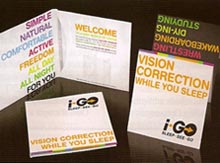
"Could orthokeratology become a volume business in the UK? Will consumers and practitioners be excited about the modality? And could it produce a customer brand such as Acuvue and Dailies have become?
These were just some of the questions arising from the launch last week of a new concept in orthokeratology. Fifty invited enthusiasts from the London area gathered in plush surroundings at the new Wembley Stadium to hear about i-GO, as much a business proposition as an addition to the lens systems already available.
Here is how it works. Selected independent practitioners are invited to sign up to the package and receive a 'free state-of-the-art' Topcon topographer, solutions and direct debit services. Practitioners and staff undertake online training and accreditation. A £1m marketing spend drives consumers to an i-GO call centre for 'pre-screening' and directing to an accredited practice in their area.
Patients pay around £50 for an initial consultation and £100 for fitting visits. If successful, they receive two pairs of lenses and commit to monthly payments of £39.50 which includes solutions and aftercare. Practitioners pay £42.50 per lens set and receive £17 per month from each patient's direct debit, leaving i-GO with £17 per patient per month after solutions and banking fees are deducted.
In its first six months, i-GO plans to have 25 accredited practices within the M25 and to extend its offer to a further 25 outside the London area within a year. It then expects to add a minimum of 25 practices annually in major conurbations across the UK until it reaches a maximum of about 200.
i-GO estimates it will deliver 100 pre-screened new customer leads per year to each practice with an average conversion of leads to patients of 2:1. It plans to generate as many as 50,000 new overnight vision correction patients in five years.
So will it succeed? Can 'overnight vision correction' appeal to consumers where orthokeratology has not?
Looking at the current market for the technique i-GO's plans are ambitious. The company accepts that the UK wearer base today is, at best, only 3,000 and possibly as low as 1,500. Yet it maintains that overnight vision correction has the potential to be 5 percent of the total contact lens market and create a substantial niche.
'Compared to what it is at the moment this is a great opportunity,' said CEO Jennifer Golden at last week's launch. Nobody's actually got on side and said "we'll drive customers in to you". We're going to do that for you,' she said.
The £1m campaign over 2-3 years will break in the London press in late March and target 18- to 35-year-old contact lens wearers with busy, active lifestyles. Packaging and marketing materials carry the 'sleep-see-go' message, stressing 'crisp, clear vision - 24 hours a day'.
Consumers will be directed to a call centre to screen out those outside Rx limits (up to -5DS and -1.50DC) or with contraindications such as diabetes. Golden said that i-GO would create a leads database for future marketing of research and would 'control the flow' of leads to accredited practices. 'We'll make sure everybody gets their fair share,' she said.
Feedback at the launch showed that practitioners' concerns about the offering among this experienced audience, were mainly financial rather than clinical. One London optometrist said that he wanted the freedom to set his own fees for chair time and another was concerned that consumers might be directed to his competitor's practice rather than his own.
Clinical and techical features of the i-GO lens were discussed, with CLO Shelly Bansal, i-GO's head of professional services, describing a trial of 21 patients at his Middlesex practice, all but two of whom were successful. Optometrist Dr Trusit Dave, independent clinical adviser to the company, also fielded questions from delegates. The i-GO lens is manifactured from the Boston XO material in the US by Euclid Systems and marketed there as the Emerald lens. The lens has been fitted to more than 100,000 eyes and was one of the first lenses to receive FDA approval for overnight wear under the Bausch & Lomb Vision Reshaping Therapy (VST) programme.
The lens has a steep reverse curve and polish-free manifacturing both of which reduce binding, a significant problem in overnight wear of any RGP and one which causes discomfort for patients. The lens is said to have a first-fit success rate of 80 per cent.
Practitioners supply the patient's SimK topography readings, iris and pupil diameters and spectacle Rx to Euclid via the i-GO website. Lenses are manifactured in Virginia then packaged and shipped to i-GO's west London base in weekly deliveries. For problem fits, the Topcon topographer allows practitioners to transfer data to Bansal's support desk (and Euclid if required) and to capture and transfer fluorescein pictures so the adviser can see everything the practitioner can see in his consulting room.
Golden said the concept was well received at the launch event although some delegates thought the offer 'too good to be true'. So who will take more convincing: consumers or practitioners? 'My gut feeling is that signing up practitioners will be the harder,' she observed. 'We're not anticipating it being plain sailing.'
Golden argues that her marketing experience in cosmetic dentistry makes i-GO the perfect product for someone with her background and interests. 'Optics is exactly the same as dentistry. You probably won't believe me but it is,' she said. With a consumer launch just weeks away, the appeal of i-GO's unusual proposition is about to be put to the test.* "
*Additional reporting by Caroline Christie.